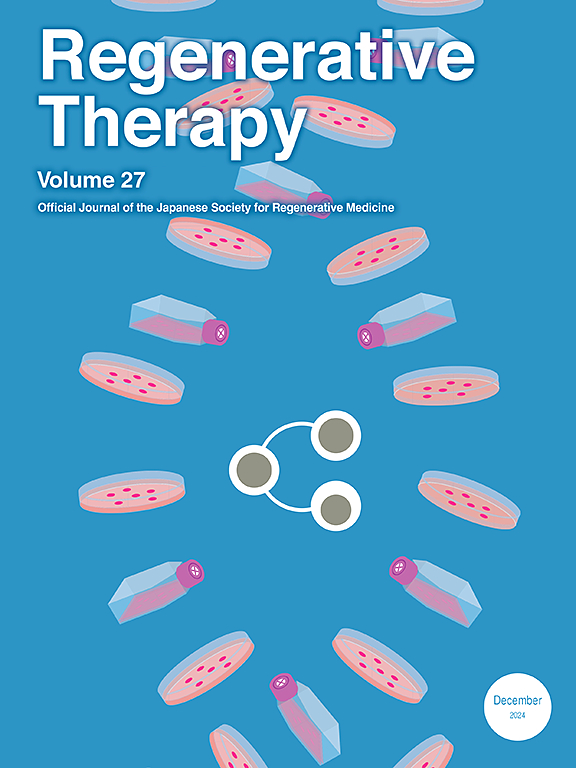眼部脂肪源间充质间质细胞的追踪:整合IVIS成像和Alu PCR增强人类细胞的检测
IF 3.5
3区 环境科学与生态学
Q3 CELL & TISSUE ENGINEERING
引用次数: 0
摘要
细胞移植在医学中有广泛的应用,从干细胞治疗到癌症研究。尽管其广泛使用,但其固有的风险,如肿瘤形成和免疫排斥,需要对移植细胞动力学有全面的了解。因此,追踪细胞行为是医学研究的一个关键方面,特别是在细胞移植的背景下。随着时间的推移,精确监测和评估移植细胞行为的能力对于评估治疗效果、安全性和长期后果至关重要。传统的成像方法,如Z-stack和叠加图像,由于样本量的限制,确定细胞位置和迁移,并且只能观察治疗应用的一个时刻,因此存在挑战。然而,最近成像技术的进步大大提高了我们在体内追踪细胞行为的能力。生物发光成像(BLI)已经成为一种无创、实时监测动物模型中细胞存活、增殖和分布的强大工具。例如,体内成像系统(IVIS)专注于其非侵入性和在实时调查中的多用途应用。基因修饰的细胞表达荧光素酶,当荧光素被施用时,允许检测光发射。BLI具有高灵敏度和长时间跟踪细胞的能力,提供关于细胞植入和持久性的重要信息。方法用CAG启动子(CAG- ffluc -cp156)下编码萤火虫荧光素酶的慢病毒载体转染人脂肪间充质干细胞(adMSCs),可以建立对adMSC行为、分布和治疗安全性的全面了解,解决干细胞应用临床评估中的一个关键障碍。该研究对转染的adMSCs进行了为期7天的跟踪,随后通过Alu-PCR分析了人类DNA分布。结果数据显示,adMSCs在第7天从受体中消失,被测器官中没有人类DNA证实了这一点。主要目的是提出一种结膜下递送的方法,研究注射后adMSCs的生物分布和迁移,并对各种细胞治疗具有潜在的意义。结论本研究为研究注射后细胞行为提供了一种有价值的方法,有助于优化临床应用的细胞治疗方法。此外,它强调了应用具有相对低致瘤潜力的adMSCs的安全性。本文章由计算机程序翻译,如有差异,请以英文原文为准。
Tracking adipose-derived mesenchymal stromal cells in the eye: Integrating IVIS imaging and Alu PCR for enhanced detection of human cells
Introduction
Cell transplantation finds broad applications in medical science, with applications ranging from stem cell therapies to cancer research. Despite its widespread use, inherent risks such as tumor formation and immune rejection necessitate a comprehensive understanding of transplanted cell dynamics. Thus, tracing cellular behavior is a critical aspect of medical research, particularly in the context of cell transplantation. The capacity to precisely monitor and evaluate the behavior of transplanted cells over time is essential for evaluating therapeutic effectiveness, safety profiles, and long-term consequences.
Traditional imaging approaches, like Z-stack and overlay images, present challenges due to limitations in sample size, determining cell location and migration, and only observing the one moment of the therapeutical application. However, recent advancements in imaging technologies have significantly improved our ability to trace cellular behavior in vivo. Bioluminescence imaging (BLI) has emerged as a powerful tool for non-invasive, real-time monitoring of cell survival, proliferation, and distribution in animal models. The in vivo imaging system (IVIS) for instance, focuses on its non-invasive nature and versatile applications in real-time investigations. Genetically modified cells express luciferase, allowing for the detection of light emission when luciferin is administered. BLI offers high sensitivity and the ability to track cells over extended periods, providing crucial information about cell engraftment and persistence.
Method
Transfecting human adipose mesenchymal stem cells (adMSCs) with a lentiviral vector encoding firefly luciferase under the CAG promoter (CAG-ffLuc-cp156), which allows to establish a comprehensive understanding of adMSC behavior, distribution, and therapeutic safety, addressing a critical obstacle in the clinical evaluation of stem cell applications. The study tracked transfected adMSCs over seven days, with subsequent analysis of human DNA distribution by Alu-PCR.
Result
Data indicates adMSCs disappear from the recipient by day 7, corroborated by the absence of human DNA in tested organs. The primary objective is to present a methodology for subconjunctival delivery, investigating the biodistribution and migration of adMSCs post-injection, with potential implications for various cell therapies.
Conclusion
This study provides a valuable methodology for investigating cell behavior post-injection, contributing to the optimization of cell therapies for clinical applications. Furthermore, it highlights the safety of applying adMSCs with relatively low potential of tumorgenicity.
求助全文
通过发布文献求助,成功后即可免费获取论文全文。
去求助
来源期刊

Regenerative Therapy
Engineering-Biomedical Engineering
CiteScore
6.00
自引率
2.30%
发文量
106
审稿时长
49 days
期刊介绍:
Regenerative Therapy is the official peer-reviewed online journal of the Japanese Society for Regenerative Medicine.
Regenerative Therapy is a multidisciplinary journal that publishes original articles and reviews of basic research, clinical translation, industrial development, and regulatory issues focusing on stem cell biology, tissue engineering, and regenerative medicine.
 求助内容:
求助内容: 应助结果提醒方式:
应助结果提醒方式:


